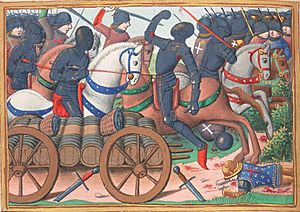Battle of the Herrings facts for kids
Quick facts for kids Battle of the Herrings |
|||||||
|---|---|---|---|---|---|---|---|
| Part of the Hundred Years' War (1415–53 phase) | |||||||
 An old drawing showing the battle, from around 1470–1479 |
|||||||
|
|||||||
| Belligerents | |||||||
| Commanders and leaders | |||||||
| Strength | |||||||
| around 4,000 | 1,600 | ||||||
| Casualties and losses | |||||||
| 500–600 | Unknown but presumably light | ||||||
The Battle of the Herrings, also known as the Battle of Rouvray, was a fight that happened on February 12, 1429. It took place near the town of Rouvray in France, just north of Orléans. This battle was part of the Hundred Years' War and happened during the siege of Orléans.
The main reason for the battle was an attempt by French and Scottish soldiers to stop a supply convoy. This convoy was heading towards the English army, which was besieging Orléans. The English had been trying to capture Orléans since October of the previous year.
The supply convoy was protected by English forces led by Sir John Fastolf. It had left Paris some time before. The English won this battle very clearly.
The supply train had about 300 carts and wagons. They carried weapons like crossbow arrows, cannons, and cannonballs. But they also carried many barrels of herring fish. These fish were being sent because the meatless Lenten days were coming soon. The large amount of fish is why the battle got its unusual name.
Contents
The Battle: How It Happened
The battle took place on a flat, open field. The French army had between 3,000 and 4,000 soldiers. They faced a much smaller English force. The English had about 1,600 soldiers.
The English set up a strong defense. They arranged their supply wagons in a circle, like a fort. They also put sharp wooden stakes all around their position. This was to stop French cavalry (soldiers on horseback) from charging. This tactic had worked very well before, at the Battle of Agincourt.
The French attack started with artillery (cannons). Cannons were quite new at this time, and people didn't fully understand how to use them best. The cannon fire did damage the English wagons and caused some injuries.
Scottish Attack and English Defense
About 400 Scottish foot soldiers attacked the English position. They did this even though their commander, the Count of Clermont, told them not to. This early attack made the French stop their cannon fire. They were afraid of hitting their own soldiers.
The Scottish soldiers did not have much armor. The English archers and crossbowmen shot at them from behind their strong "wagon fort." This caused a lot of damage to the Scots.
French cavalry tried to help the Scottish soldiers. But the English archers and the sharp wooden stakes stopped them. At this point, the English saw that the rest of the French foot soldiers were not joining the attack. They seemed to be moving slowly and without courage.
So, the English decided to attack back. They hit the French and Scottish forces from behind and from the sides. The French and Scottish soldiers became disorganized and ran away.
After the battle, the English convoy regrouped. They continued their journey and successfully delivered supplies to the English army besieging Orléans. This battle had a big impact on the spirits of both sides.
Historians believe the battle likely happened near Rouvray-Sainte-Croix. The combined French and Scottish forces lost about 400 men. This included John Stewart, the leader of the Scots. Jean de Dunois, also known as the Bastard of Orléans, was wounded. He barely survived and later played a key role with Joan of Arc.
Aftermath and Importance
Many people today think the French lost the Battle of the Herrings because they stopped their cannon fire too soon. However, people at the time, especially in Orléans, had a different view. Inside the city, many blamed the Count of Clermont for the loss. They thought he was a coward.
Soon after the battle, Clermont and the wounded Count Dunois left Orléans. About 2,000 soldiers left with them. Morale inside the city was very low. Some leaders even thought about surrendering the city to the English.
The Battle of the Herrings was the most important military event during the siege of Orléans. This was true from October 1428 until Joan of Arc arrived in May of the next year. Even so, it was a fairly small fight. If it hadn't happened during such a famous siege, it might have been forgotten.
Joan of Arc's Role
The battle also became important because of a story involving Joan of Arc. It is said that the battle played a key role in convincing Robert de Baudricourt to help Joan. Joan wanted support and safe travel to Chinon to meet the Dauphin (the French prince).
On the very day of the battle (February 12, 1429), Joan met with de Baudricourt for the last time. According to the story, Joan told him that "the Dauphin's army had suffered a great defeat near Orléans that day." Several days later, news of the French loss at Rouvray did reach Vaucouleurs. The story says that de Baudricourt then changed his mind. He agreed to help Joan travel to the Dauphin in Chinon. Joan finally left Vaucouleurs for Chinon on February 23, 1429.
See also


